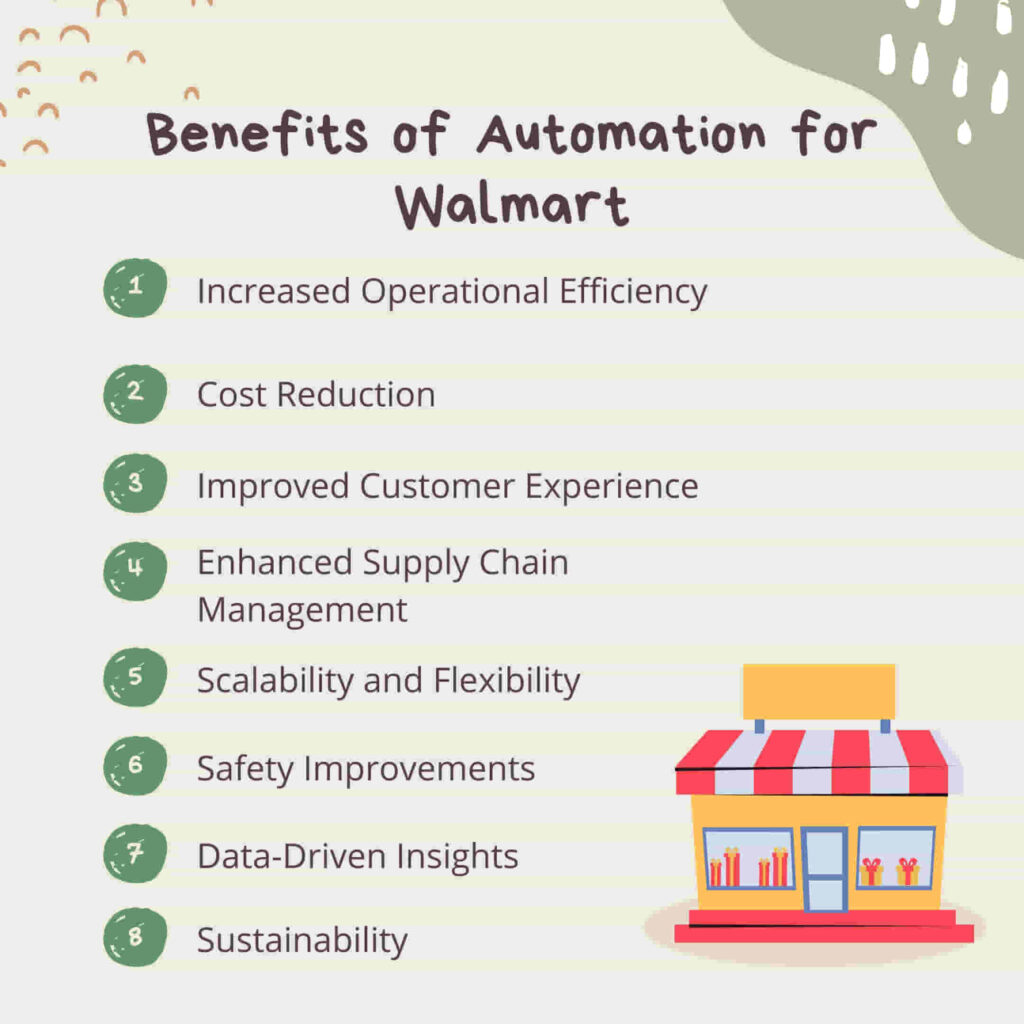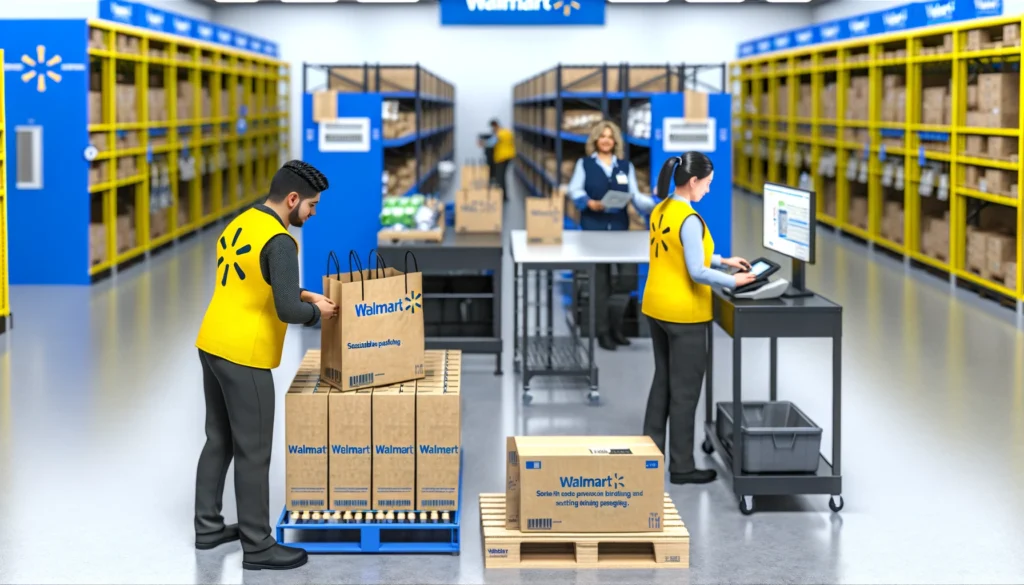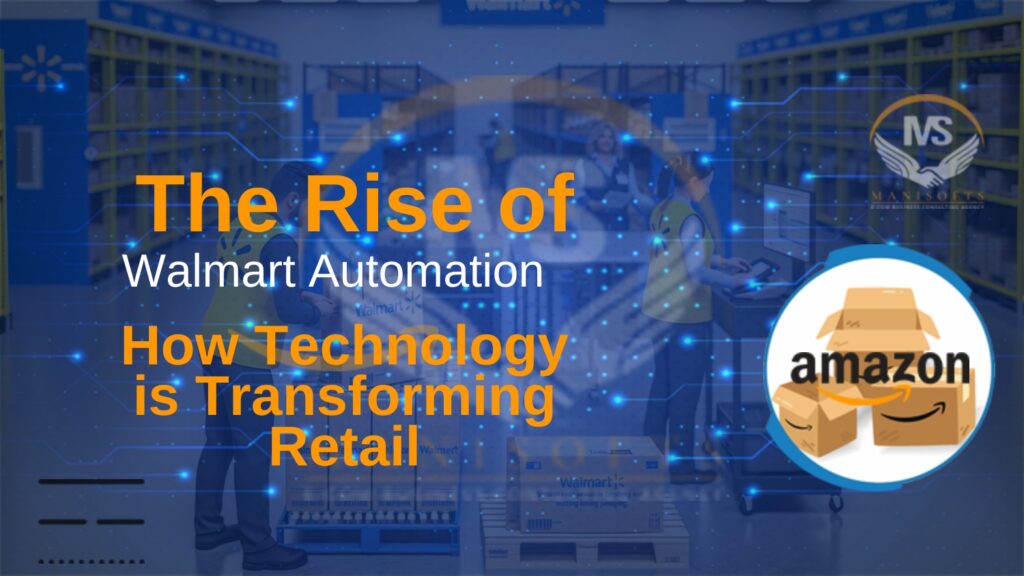Uncover Walmart Automation Revolution! Explore how robots, AI, and technology are transforming Walmart’s operations, impacting efficiency, delivery, and the future of retail. Learn the benefits for customers and employees.
Introduction
Walmart’s adoption of automation technologies significantly enhances its operational efficiency and customer service. By implementing robotics in logistics for inventory management and order fulfillment, and integrating self-service kiosks and mobile checkout options in stores, Walmart streamlines both backend processes and customer interactions. These technological advancements not only reduce operational costs but also speed up service, providing Walmart with a competitive edge in the retail industry. Additionally, the use of AI for predictive analytics helps Walmart better anticipate market trends and customer needs, further refining its business strategy.
Table of contents
Walmart Automation
Walmart has been increasingly integrating automation into its operations to enhance efficiency, improve customer service, and streamline its supply chain. Here’s an overview of how Walmart is leveraging automation across different facets of its business:
In-Store Automation
Self-Checkout Systems
Walmart has expanded the use of self-checkout kiosks to reduce wait times and allow customers to have more control over their shopping experience. These systems are designed to handle transactions quickly, reducing the need for staffed checkout lanes.
Robotic Cleaners
Automated floor cleaners, which resemble large robotic vacuum cleaners, are used in many Walmart stores. These robots can navigate around obstacles and people, ensuring that the floors are consistently clean without requiring constant human oversight.
Online and Fulfillment Automation
Warehouse Automation
Walmart has invested in automated systems in its warehouses to expedite the process of picking, packing, and shipping. This includes the use of conveyor belts, sorting robots, and drones that can manage inventory and prepare items for delivery more efficiently than human workers.
Pickup Towers
In several locations, Walmart has introduced automated Pickup Towers. These are essentially high-tech vending machines that dispense products ordered online. Customers scan a barcode on their smartphone, and the machine retrieves the correct item, making the pickup process quick and contactless.
Supply Chain and Logistics Automation
Autonomous Trucks
Walmart is experimenting with autonomous trucks for long-haul deliveries. This technology aims to reduce the costs and complexities associated with shipping logistics, and enhance safety by reducing human error.
Inventory Management Robots
Walmart uses robots in some stores to scan shelves for inventory levels, pricing accuracy, and misplaced items. These robots provide real-time data that can help in managing stock more effectively and ensuring product availability.
Challenges and Future Directions
While automation presents numerous opportunities, it also comes with challenges. Concerns include the potential displacement of jobs, the need for significant capital investment, and the technological limitations of current systems. However, Walmart continues to invest in research and development to overcome these challenges and further integrate automation into its operations.
By embracing automation, Walmart aims to maintain its competitive edge, improve operational efficiencies, and meet the evolving expectations of its customers. The ongoing evolution of automation technologies suggests that Walmart will continue to innovate in this area to enhance its business processes and customer service.
Benefits of Automation for Walmart

Automation offers a range of benefits for Walmart, particularly as the retail giant seeks to improve efficiency, reduce costs, and enhance customer satisfaction. Here’s a detailed look at the key advantages of automation for Walmart:
Increased Operational Efficiency
Automation significantly enhances operational efficiency in Walmart’s stores and distribution centers. Automated systems, like conveyor belts, sorting robots, and self-checkout kiosks, speed up the handling and processing of goods and customer transactions. This not only saves time but also reduces the likelihood of errors that can occur with manual processes.
Cost Reduction
By automating various processes, Walmart can lower its labor costs. Automation reduces the need for staff in certain areas, such as cashier roles and janitorial services, by using self-checkouts and robotic cleaners. Additionally, automated inventory management systems minimize the losses associated with overstocking or stockouts, further cutting costs.
Improved Customer Experience
Automation helps Walmart offer a more consistent and reliable shopping experience. For example, self-checkout stations allow customers to avoid long lines, and robotic assistance can guide or provide information to shoppers in the aisles. Furthermore, automated inventory systems ensure products are adequately stocked and accurately priced, which improves overall customer satisfaction.
Enhanced Supply Chain Management
Automation plays a crucial role in optimizing Walmart’s supply chain. Automated warehouses help streamline the picking, packing, and shipping processes, making it faster and more efficient to get products to stores and customers. The use of autonomous trucks and drones for delivery can also reduce shipping times and improve the freshness of perishable goods.
Scalability and Flexibility
Automation provides Walmart with the scalability necessary to handle peak shopping periods without the need to significantly increase temporary staff. This flexibility is crucial in retail, where demand can fluctaneously based on seasons, promotions, and other factors.
Safety Improvements
Automated processes can also enhance safety in Walmart’s operations. For instance, using robots for tasks that involve heavy lifting or repetitive motions can reduce workplace injuries. Autonomous cleaning and maintenance robots minimize the need for human involvement in potentially hazardous tasks.
Data-Driven Insights
Robots and automated systems constantly collect data on inventory levels, customer behavior, and operational efficiency. This wealth of data allows Walmart to make informed decisions quickly, adapting to market changes more effectively and planning future strategies based on solid analytics.
Sustainability
Automation can contribute to Walmart’s sustainability efforts by optimizing delivery routes to reduce fuel consumption and by ensuring more efficient use of energy in warehouses. These improvements help Walmart reduce its carbon footprint and contribute to environmental conservation.
Case Study: Walmart’s Use of Robotics in Operations

Walmart, one of the largest retail corporations globally, has continuously innovated to maintain its competitive edge. One of the key areas where Walmart has invested heavily is the integration of robotics in its operations. This case study explores how Walmart leverages robotics to enhance efficiency, reduce costs, and improve customer service across its vast network of stores and distribution centers.
Background
Walmart, founded in 1962, has grown to operate thousands of stores worldwide. As the retail landscape evolves, Walmart has embraced technology to streamline its operations. Robotics plays a crucial role in this technological transformation, addressing various challenges such as inventory management, order fulfillment, and customer service.
Robotics in Walmart’s Operations
1. Inventory Management
Automated Shelf Scanners: Walmart uses autonomous robots equipped with cameras and sensors to scan shelves. These robots, often referred to as “shelf-scanning robots,” identify out-of-stock items, incorrect prices, and misplaced products. This automation ensures shelves are consistently stocked, improving inventory accuracy and reducing the workload for employees.
2. Order Fulfillment
Automated Storage and Retrieval Systems (AS/RS): In Walmart’s distribution centers, AS/RS technology is employed to automate the storage and retrieval of goods. These systems use robotics to move products efficiently within the warehouse, optimizing space utilization and speeding up the order fulfillment process. This technology significantly reduces the time it takes to pick and pack orders, enhancing overall productivity.
Robotic Fulfillment Centers: Walmart has also invested in high-tech fulfillment centers where robots play a central role. These robots are responsible for picking, packing, and shipping online orders. By automating these tasks, Walmart can handle a higher volume of orders with greater accuracy and speed, meeting the growing demand for e-commerce.
3. Customer Service
Autonomous Floor Cleaners: In many Walmart stores, autonomous floor-cleaning robots, often referred to as “robot janitors,” are deployed. These robots navigate the store independently, cleaning floors and ensuring a tidy shopping environment. This automation allows employees to focus on more customer-centric tasks.
Robotic Process Automation (RPA): Walmart uses RPA to streamline various back-office functions such as payroll processing, employee onboarding, and customer service inquiries. By automating repetitive and time-consuming tasks, Walmart enhances efficiency and reduces the potential for human error.
Benefits of Robotics in Walmart’s Operations
1. Increased Efficiency
Robotics technology significantly enhances operational efficiency by automating repetitive tasks. This efficiency translates to faster order processing, reduced waiting times for customers, and streamlined inventory management.
2. Cost Reduction
Automation helps Walmart reduce labor costs associated with manual tasks. Robots can operate 24/7 without breaks, leading to cost savings in the long run. Additionally, the increased accuracy in inventory management reduces losses from stock discrepancies.
3. Improved Customer Experience
By ensuring shelves are always stocked and orders are fulfilled promptly, Walmart enhances the shopping experience for its customers. The use of robotics in customer service roles, such as floor cleaning, ensures a clean and pleasant store environment.
4. Enhanced Employee Productivity
Robots handle mundane and physically demanding tasks, allowing employees to focus on more value-added activities. This shift in responsibilities can lead to higher job satisfaction and productivity among staff.
Challenges and Considerations
1. Initial Investment
The implementation of robotics technology requires significant upfront investment. Walmart has had to allocate substantial resources to purchase, deploy, and maintain robotic systems. However, the long-term benefits often outweigh the initial costs.
2. Workforce Impact
The introduction of robotics has raised concerns about potential job displacement. Walmart has addressed these concerns by emphasizing that robots are intended to augment human labor, not replace it. The company focuses on retraining and upskilling employees to work alongside robots.
3. Technical Issues
Like any technology, robotics systems can encounter technical issues. Walmart must ensure robust maintenance and support systems are in place to minimize downtime and address any malfunctions promptly.
Walmart’s Online Grocery Pickup and Delivery Automation
Walmart’s Online Grocery Pickup and Delivery service is a significant component of the retail giant’s strategy to integrate technology and convenience in its shopping experience. Here, we explore how automation has been pivotal in enhancing and scaling this service.
Introduction to Automation in Grocery Pickup and Delivery
Walmart has invested heavily in automation to streamline its grocery pickup and delivery operations. This investment is part of a broader strategy to meet consumer demand for faster, more reliable service. Automation in this sector typically involves the use of sophisticated software systems, robotics, and artificial intelligence (AI) to manage and expedite orders efficiently.
Key Components of Automation
1. Inventory Management
Automation technology helps Walmart maintain real-time inventory tracking, which is crucial for the accuracy of online grocery orders. Automated systems update inventory levels as soon as changes occur, reducing the likelihood of order errors and ensuring that customers always know what’s available.
2. Order Processing
AI algorithms optimize order processing by analyzing data such as order frequency, item location, and delivery logistics. This optimization leads to faster preparation and more accurate order fulfillment.
3. Robotic Picking Systems
In some locations, Walmart uses robotic picking systems to gather items from the shelves. These robots work alongside human employees to increase picking speed and reduce errors, improving overall efficiency.
4. Routing and Delivery Optimization
For deliveries, automated systems calculate the most efficient delivery routes. This not only speeds up the delivery process but also helps in reducing fuel consumption and emissions, aligning with sustainability goals.
Benefits of Automation
- Efficiency: Automated systems can handle multiple tasks simultaneously, reducing the time from order to pickup or delivery.
- Accuracy: Reduced human error in order picking and inventory management means customers receive exactly what they ordered.
- Scalability: Automation allows Walmart to handle a larger volume of orders without a corresponding increase in errors or delays.
- Customer Satisfaction: Faster service and accurate orders enhance the customer experience, fostering loyalty.
Challenges and Solutions
Despite the benefits, automation also presents challenges. Privacy concerns, the displacement of jobs, and initial setup costs are significant issues. Walmart addresses these challenges by implementing strict data security measures, retraining employees for new roles in the automated environment, and calculating long-term savings and efficiencies to justify upfront expenses.
Future Directions
Walmart continues to explore advancements in AI and robotics to further enhance its grocery pickup and delivery services. Future enhancements may include more personalized shopping experiences through machine learning and further integration of autonomous vehicles for delivery.
FAQ’s
An example of Walmart’s automated warehouse is the Alphabot system, used in select stores to manage online grocery orders. This system employs compact robots to pick and pack grocery items, which are then passed to a human worker for quality checks and final packaging.
Walmart’s newest AI platform, named Wallaby, is built using Walmart’s own data to develop large language models (LLMs) designed for tailored experiences within the Walmart setting. Additionally, Walmart has enhanced its customer support assistant with advanced AI features to improve service.
In 2020, Walmart restructured its management roles by eliminating Department Manager positions, replacing them with Team Leads.
My Schedule App: Manage scheduling, PTO, leave, and absences. Powered by generative AI. Results may vary in accuracy. Usage follows the Generative AI Guidelines and Walmart’s applicable policies.
Discover how automated solutions can boost efficiency, lower costs, and increase accuracy in warehouse operations. As logistics evolve, warehouse automation is on the rise, with over a quarter of all warehouses projected to be automated by 2027.
Conclusion
Walmart’s implementation of automation across its operations signifies a transformative shift in retail management and customer service. By integrating advanced technologies such as AI, machine learning, and robotic systems, Walmart has not only increased efficiency and accuracy in inventory management and order processing but has also set a new standard for the retail industry.
This strategic adoption of automation enables the company to handle a higher volume of transactions with greater precision, leading to improved customer satisfaction and loyalty. As Walmart continues to refine its automation processes and explores new technologies, it is poised to further enhance its operational capabilities and maintain its competitive edge in the rapidly evolving retail landscape.




